Abstract
OBJECTIVES: This study evaluated a community organization approach that emphasized involvement of audiences in program planning and implementation in promoting nonsmoking among African American residents of low-income neighborhoods. METHODS: The quasi-experimental design involved a 24-month intervention in 3 low-income, predominantly African American neighborhoods in St. Louis. Intervention neighborhoods were compared with comparable, untreated neighborhoods in Kansas City. RESULTS: The program was successful in engaging audience members in its governance and in instigating numerous and diverse neighborhood activities to promote nonsmoking. The prevalence of smoking declined from 34% to 27% in program neighborhoods but only from 34% to 33% in comparison neighborhoods. This difference was apparent within all demographically defined subsamples, indicating that observed changes were consistent and not attributable to confounding by demographic characteristics. CONCLUSIONS: A community organization approach emphasizing local authority for program decisions and involvement of informal networks may have an appreciable impact on smoking among residents of low-income, African American neighborhoods.
Full text
PDF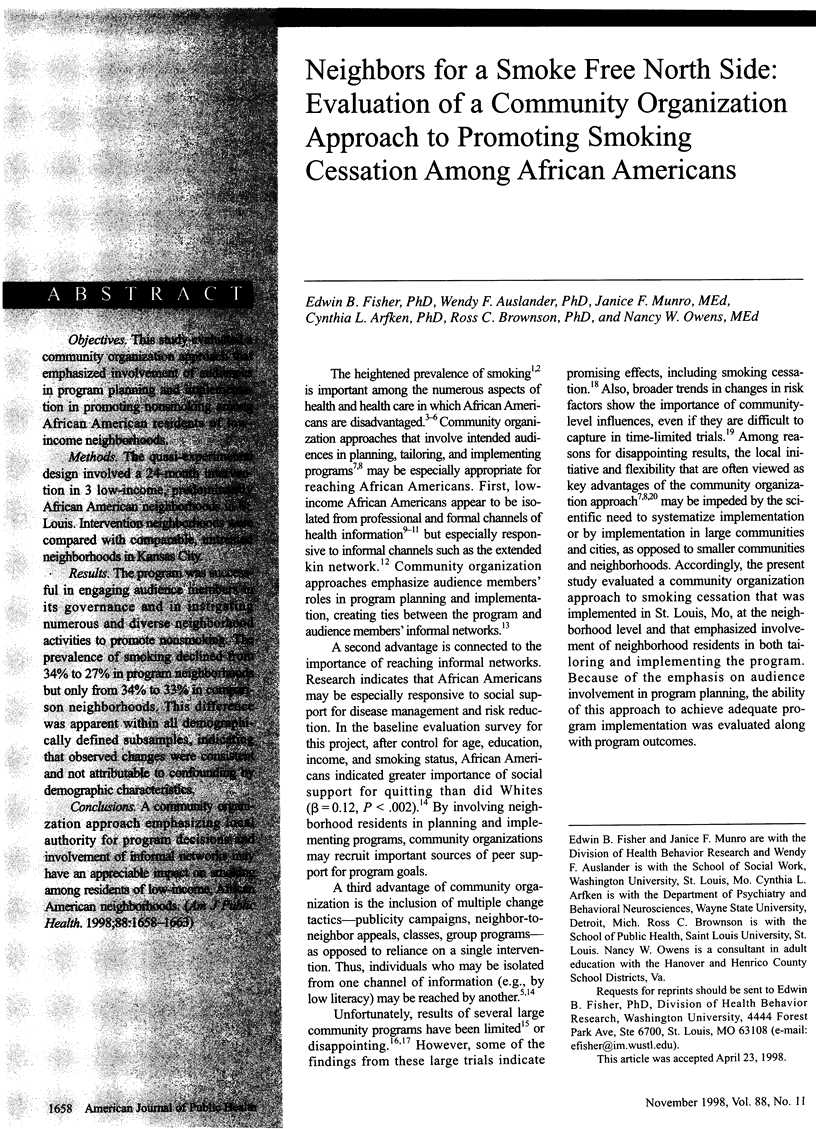
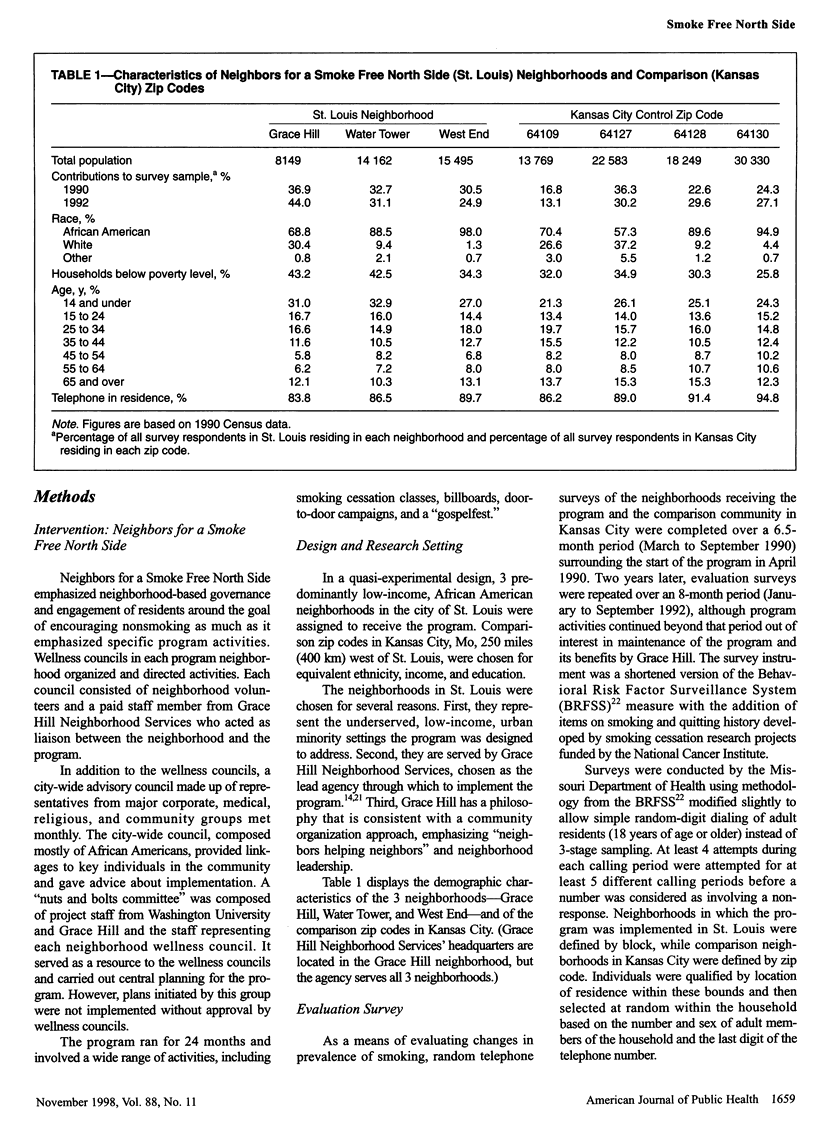
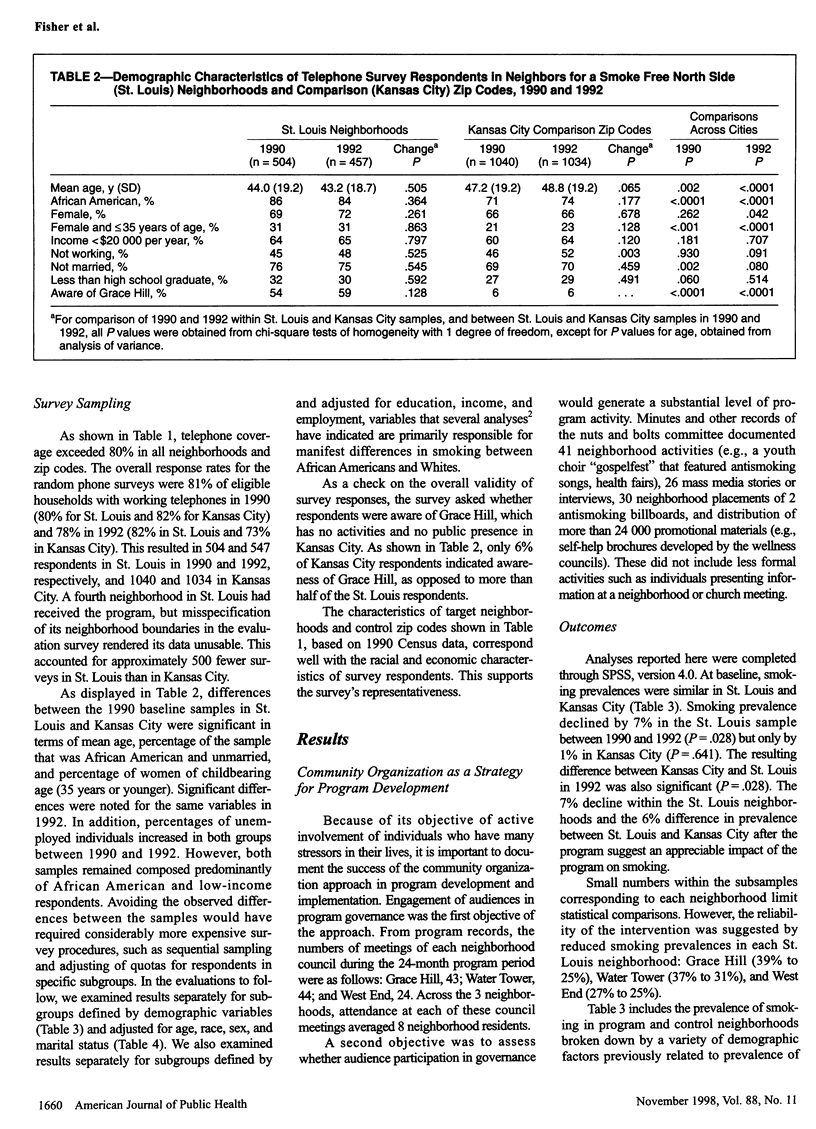
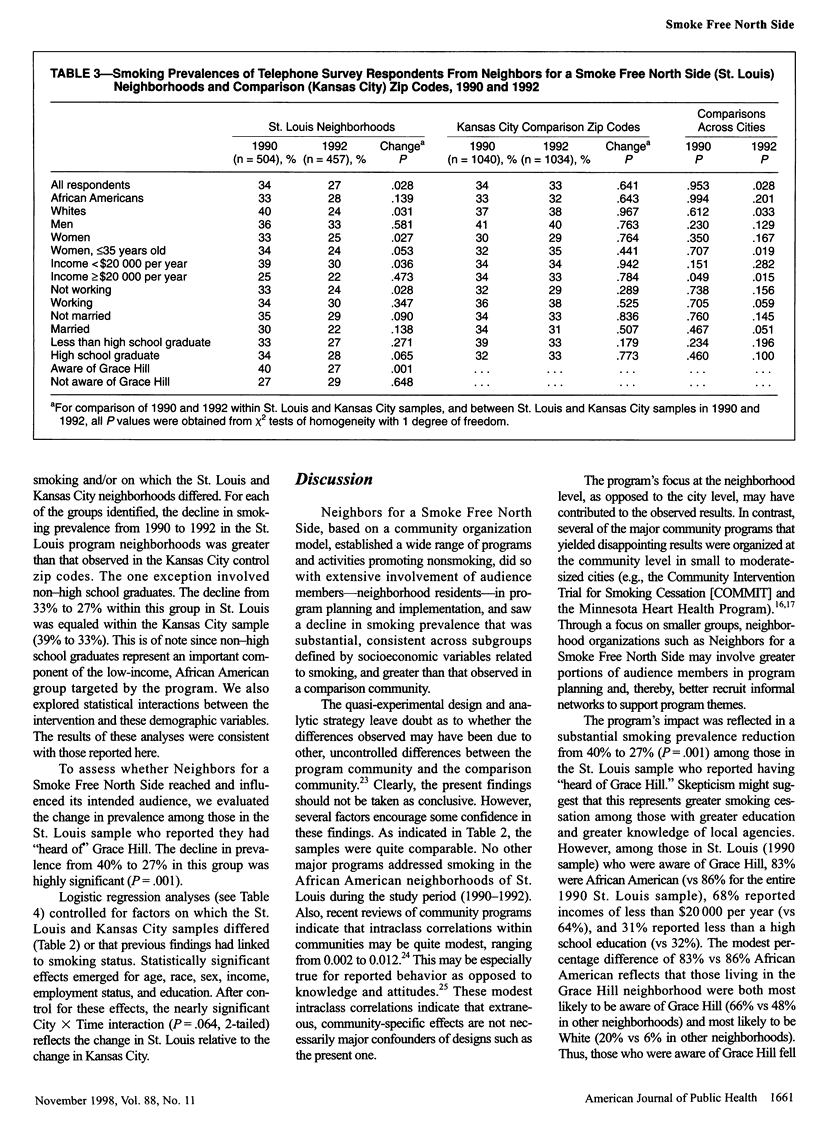
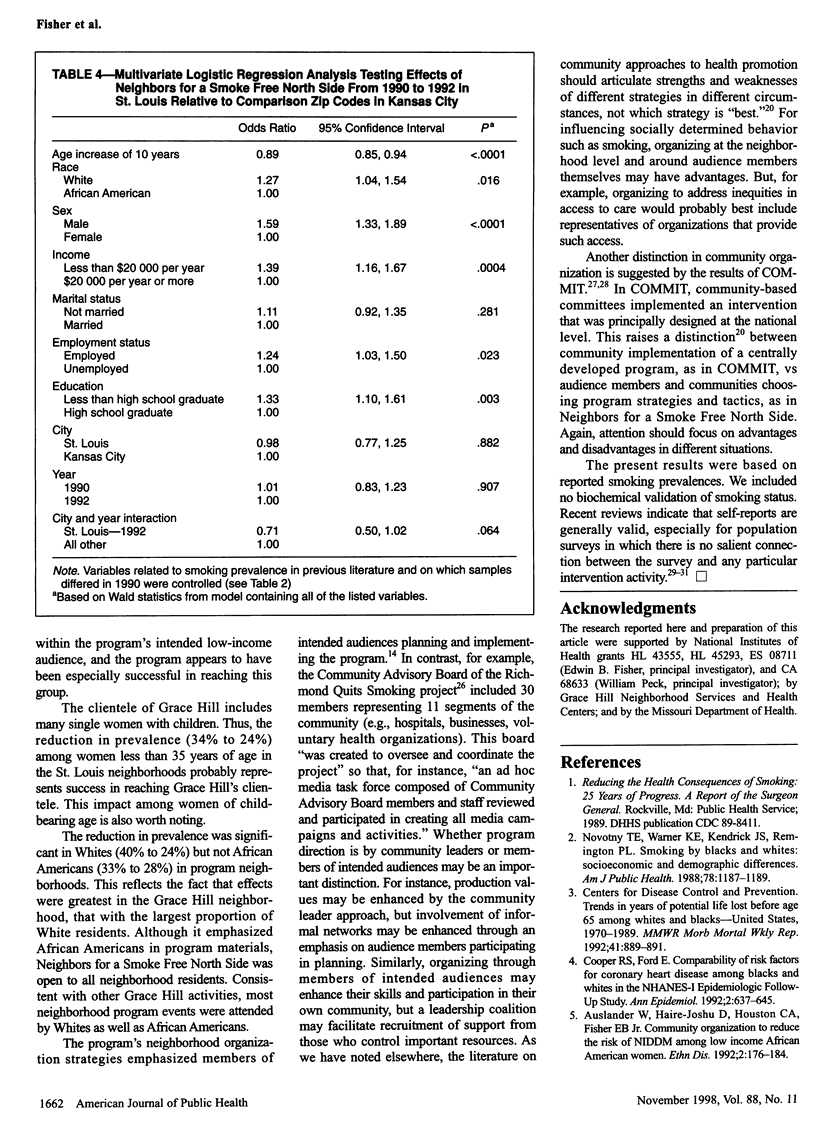
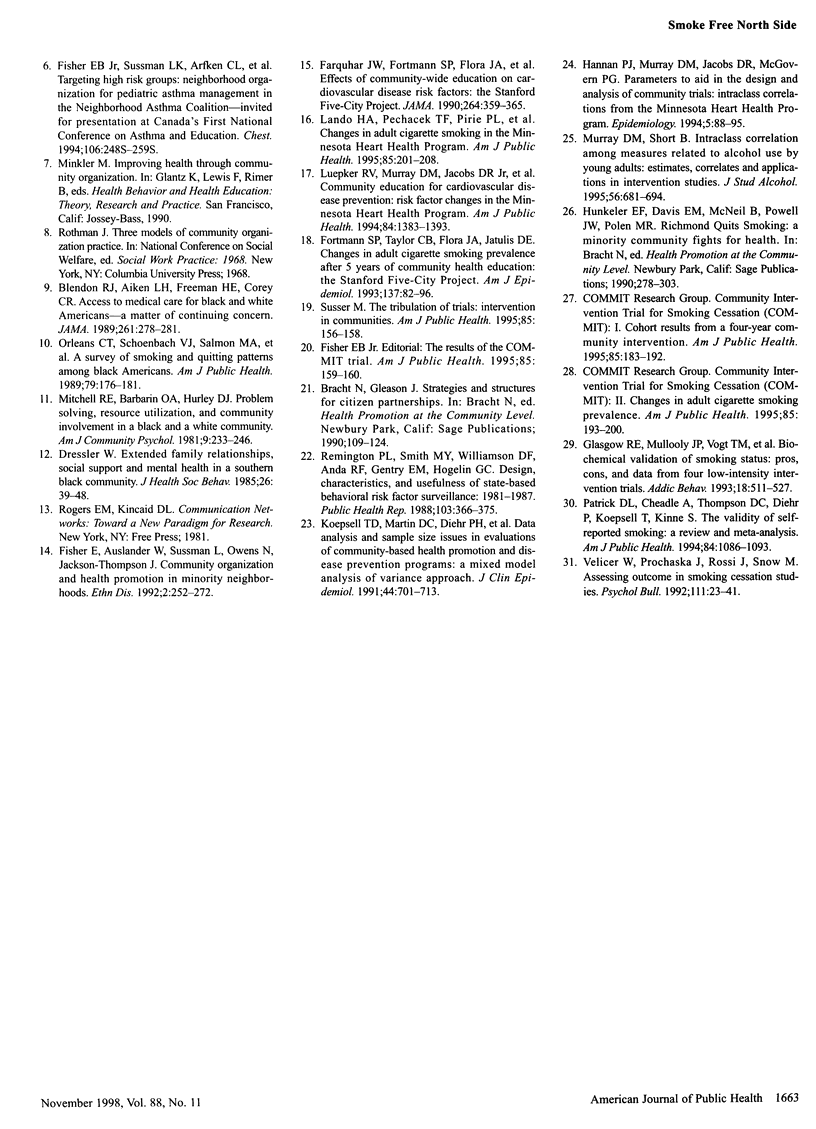
Selected References
These references are in PubMed. This may not be the complete list of references from this article.
- Auslander W. F., Haire-Joshu D., Houston C. A., Fisher E. B., Jr Community organization to reduce the risk of non-insulin-dependent diabetes among low-income African-American women. Ethn Dis. 1992 Spring;2(2):176–184. [PubMed] [Google Scholar]
- Blendon R. J., Aiken L. H., Freeman H. E., Corey C. R. Access to medical care for black and white Americans. A matter of continuing concern. JAMA. 1989 Jan 13;261(2):278–281. [PubMed] [Google Scholar]
- Cooper R. S., Ford E. Comparability of risk factors for coronary heart disease among blacks and whites in the NHANES-I Epidemiologic Follow-up Study. Ann Epidemiol. 1992 Sep;2(5):637–645. doi: 10.1016/1047-2797(92)90008-e. [DOI] [PubMed] [Google Scholar]
- Dressler W. W. Extended family relationships, social support, and mental health in a southern black community. J Health Soc Behav. 1985 Mar;26(1):39–48. [PubMed] [Google Scholar]
- Farquhar J. W., Fortmann S. P., Flora J. A., Taylor C. B., Haskell W. L., Williams P. T., Maccoby N., Wood P. D. Effects of communitywide education on cardiovascular disease risk factors. The Stanford Five-City Project. JAMA. 1990 Jul 18;264(3):359–365. [PubMed] [Google Scholar]
- Fisher E. B., Jr, Auslander W., Sussman L., Owens N., Jackson-Thompson J. Community organization and health promotion in minority neighborhoods. Ethn Dis. 1992 Summer;2(3):252–272. [PubMed] [Google Scholar]
- Fisher E. B., Jr, Sussman L. K., Arfken C., Harrison D., Munro J., Sykes R. K., Sylvia S., Strunk R. C. Targeting high risk groups. Neighborhood organization for pediatric asthma management in the Neighborhood Asthma Coalition. Chest. 1994 Oct;106(4 Suppl):248S–259S. doi: 10.1378/chest.106.4_supplement.248s. [DOI] [PubMed] [Google Scholar]
- Fisher E. B., Jr The results of the COMMIT trial. Community Intervention Trial for Smoking Cessation. Am J Public Health. 1995 Feb;85(2):159–160. doi: 10.2105/ajph.85.2.159. [DOI] [PMC free article] [PubMed] [Google Scholar]
- Fortmann S. P., Taylor C. B., Flora J. A., Jatulis D. E. Changes in adult cigarette smoking prevalence after 5 years of community health education: the Stanford Five-City Project. Am J Epidemiol. 1993 Jan 1;137(1):82–96. doi: 10.1093/oxfordjournals.aje.a116605. [DOI] [PubMed] [Google Scholar]
- Glasgow R. E., Mullooly J. P., Vogt T. M., Stevens V. J., Lichtenstein E., Hollis J. F., Lando H. A., Severson H. H., Pearson K. A., Vogt M. R. Biochemical validation of smoking status: pros, cons, and data from four low-intensity intervention trials. Addict Behav. 1993 Sep-Oct;18(5):511–527. doi: 10.1016/0306-4603(93)90068-k. [DOI] [PubMed] [Google Scholar]
- Hannan P. J., Murray D. M., Jacobs D. R., Jr, McGovern P. G. Parameters to aid in the design and analysis of community trials: intraclass correlations from the Minnesota Heart Health Program. Epidemiology. 1994 Jan;5(1):88–95. doi: 10.1097/00001648-199401000-00013. [DOI] [PubMed] [Google Scholar]
- Koepsell T. D., Martin D. C., Diehr P. H., Psaty B. M., Wagner E. H., Perrin E. B., Cheadle A. Data analysis and sample size issues in evaluations of community-based health promotion and disease prevention programs: a mixed-model analysis of variance approach. J Clin Epidemiol. 1991;44(7):701–713. doi: 10.1016/0895-4356(91)90030-d. [DOI] [PubMed] [Google Scholar]
- Lando H. A., Pechacek T. F., Pirie P. L., Murray D. M., Mittelmark M. B., Lichtenstein E., Nothwehr F., Gray C. Changes in adult cigarette smoking in the Minnesota Heart Health Program. Am J Public Health. 1995 Feb;85(2):201–208. [PMC free article] [PubMed] [Google Scholar]
- Luepker R. V., Murray D. M., Jacobs D. R., Jr, Mittelmark M. B., Bracht N., Carlaw R., Crow R., Elmer P., Finnegan J., Folsom A. R. Community education for cardiovascular disease prevention: risk factor changes in the Minnesota Heart Health Program. Am J Public Health. 1994 Sep;84(9):1383–1393. doi: 10.2105/ajph.84.9.1383. [DOI] [PMC free article] [PubMed] [Google Scholar]
- Murray D. M., Short B. Intraclass correlation among measures related to alcohol use by young adults: estimates, correlates and applications in intervention studies. J Stud Alcohol. 1995 Nov;56(6):681–694. doi: 10.15288/jsa.1995.56.681. [DOI] [PubMed] [Google Scholar]
- Novotny T. E., Warner K. E., Kendrick J. S., Remington P. L. Smoking by blacks and whites: socioeconomic and demographic differences. Am J Public Health. 1988 Sep;78(9):1187–1189. doi: 10.2105/ajph.78.9.1187. [DOI] [PMC free article] [PubMed] [Google Scholar]
- Orleans C. T., Schoenbach V. J., Salmon M. A., Strecher V. J., Kalsbeek W., Quade D., Brooks E. F., Konrad T. R., Blackmon C., Watts C. D. A survey of smoking and quitting patterns among black Americans. Am J Public Health. 1989 Feb;79(2):176–181. doi: 10.2105/ajph.79.2.176. [DOI] [PMC free article] [PubMed] [Google Scholar]
- Patrick D. L., Cheadle A., Thompson D. C., Diehr P., Koepsell T., Kinne S. The validity of self-reported smoking: a review and meta-analysis. Am J Public Health. 1994 Jul;84(7):1086–1093. doi: 10.2105/ajph.84.7.1086. [DOI] [PMC free article] [PubMed] [Google Scholar]
- Remington P. L., Smith M. Y., Williamson D. F., Anda R. F., Gentry E. M., Hogelin G. C. Design, characteristics, and usefulness of state-based behavioral risk factor surveillance: 1981-87. Public Health Rep. 1988 Jul-Aug;103(4):366–375. [PMC free article] [PubMed] [Google Scholar]
- Susser M. The tribulations of trials--intervention in communities. Am J Public Health. 1995 Feb;85(2):156–158. doi: 10.2105/ajph.85.2.156. [DOI] [PMC free article] [PubMed] [Google Scholar]
- Velicer W. F., Prochaska J. O., Rossi J. S., Snow M. G. Assessing outcome in smoking cessation studies. Psychol Bull. 1992 Jan;111(1):23–41. doi: 10.1037/0033-2909.111.1.23. [DOI] [PubMed] [Google Scholar]


